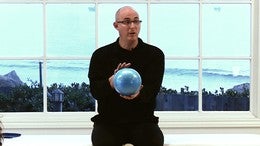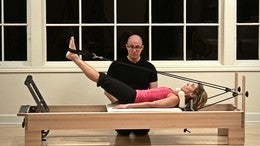Description
About This Video
Transcript
Read Full Transcript
Hello. My name is Juan Nieto. I'm from Spain and I'm here with Christina. That is so nice to be with us. Um, we're going to do a back here or back pain class. Um, it's very important to understand that when we have pain in our low back, it's very common that one, we can stop moving. That's one of the options that we take. And the other one or we start to move in in a, in a funny way. So our movement changes.
So the way our tissues communicates with our brain and the brain with our tissues changes. So it's a very good tool to recover this, to use the, the [inaudible] method and the exercise in order to facilitate the good functioning of the, of the system. So first we need to understand how is the this low back working. So we are going to do a very easy assessment with Christina. So Hi Christina. What I wanted to do is just to lift this knee up like that exercise.
Okay? And now let it go. Go down. And now the other one. Okay. So when you do this kind of assessment is very important that you understand how is the system reacting. So they put it down, uh, in order to control this way. That is not that much. It's just a tiny liver because it's not, the long leg is just the bent leg. So we are supportive with the floor. Uh, we shouldn't be using a lot of muscle activity.
So sometimes we have an association with between low back pain on weakness into the abdominals. The reality is that is not about weakness. It's more about the timing and the recruitment and the coordination of the different muscles and not as much as our muscles. So sometimes people has a tendency to over recruit. There are Domino's, but it is proven that a lot of recruitment into abdominous creates, creates more intraabdominal pressure and that can be even worse for the system. So I'm going to give some feedback to Christina in order to facilitate this. This moment. What I saw is that she's using a lot of superficial abdominals, um, that maybe is telling me that the lower dominoes are not working, uh, the way it should. So first, Christina, I'm gonna take you up my hand into your lumbar Lordosis. That's it. Okay.
All right. And I want you to focus on the segment. So when we put emphasis on the sake room, we are facilitating their, um, uh, lumbar extension. So we are using the multifidus and Multifidi is one of the muscles that innovates very often when there's pain. So now I want you to keep this activity and kept the same feeling in my hand. When you lift one of the legs. Perfect.
Are you feeling the sacrum? Perfect. So I want you to keep the sacrum, that position, like a very strong filling in the, and now leave the other one. Perfect. So now we're using the legs as I load for our lumbar spine and Christina starting to control the movement. So let's do continuously.
So I'm gonna help you to, to drive, if we can make this a little bit easier for you. Okay. So try not to do anything and let me live my life and try to find the leg very relaxed. I'm very deep into this. Okay? Okay. Awesome. Do you feel any muscle activity here? Okay. So yeah, that's very slowly let it go and try to experience this, this feeling.
So little by little they will help you less. There you go and you will take care of it.
If they can in a conscious way, uh, understand what they need to feel and they are successful during the movement, they will be able to replicate into, into the next day. So, so most of the times we need to start, uh, here, uh, every low back pain class. So feel the sacrum again and now. Okay, let me help you. I will less, less activity.
You feel that your nervous system is telling you that you need all this recruitment in this, a quiet, the quieter thefts. Okay? But this is what I really need you to feel so focused on the lumbar spine. Are you feeling that you're keeping the distance with my hand? So I keep in the hand as a sensor to understand what is going on there and I, I'm helping her little by little less and less and less and less and less.
And now I can see that the motion is much better.
So what I wanted you to do is to open the right knee
The organization is good. The range of motion needs, it's enough. So we're going to see the other one.
So I am applying a little pressure and I want you to react to that pressure. Okay. So let's do it.
The thing is that before when you open, you didn't know that your lumbars were moving. So it was a lack of information. Maybe because your tissues are not sending the right, the right signal or your brain is not interpretating in a in a correct way. So let's do it a couple of times, kid. This pressure here and in the left side and also in the right side.
Perfect. Okay.
If we cannot stabilize the Lumbar, the hips lose their movement. So as a way of recover the movement, if we work and we take attention into the hips at the same time that we are understanding how to establish the lumbars, sometimes when there's pain, an exercise as simple as the pelvic clock can be irritating. And if you're working with a client that has a pain experience and you continue working in our pain environment, even though the exercise is so simple, the brain of the person is in a protective mode. So it's very difficult to get rid of. The image of the movement is the cause of the pain. So we really need to get to a pain contingents [inaudible] or exercise.
In a way that they can understand that exercise is what is helping them instead of exercises or cause of of the problem. All right, so now that we have all this, we're going to go to a more complex success. It's not that much, but little bit later, we need to gradually increase the difficulty if you're going to do their bridging exercise. All right? What I want you to do, Christina, is to focus on the hip extension. Okay? So bridging is a hip extension exercise where the lumbars needs to distribute the movement a little bit later. So I don't want a lot of movement in the spine. You made it very, very well, but I want you to focus in length, in length and length in the spine as much as you can. And now let's gradually lengthen the pelvis towards this wall. Well, the gravity's letting you come back into the [inaudible] in the
Okay, let's, I'm going to stop with you there. I want you to feel that motion there. Okay? So it's a little bit more or less movement, but it's longer. Okay. So what we really want to do is a little bit of movement in every joint, not a lot of movement in every joint, just a tiny bit. Okay. So now I want you to focus on the hips. So lengthen hips, fill their weights into your big toe and the big ball.
And now lengthen length and Landon fan smashes. You can, that's perfect. So you don't really need to feel every Spanish process into the floor. Just feel that there's a little movement in every, every, every joint. Okay. So let's do it again. Perfect. Cool. So if you are working with a person who has pain, it's okay to have like a little bit, uh, a little bit, all a little bit of asymmetric construction here, like keeping them like eight or 10 seconds in order to recruit the glutes, not the hamstrings, but the glutes.
So it is demonstrated that this is symmetrical work here. It reduces pain. So that could, that can be a tool to help you out. So let's do it again. Um, yeah. So, so yeah, I really, okay. Sometimes even this exercise can be irritating for the person. So one of the tools that we can use is to self limits the mobility into the lumbars through some sort of a pattern with the, with the hips.
So now what we're going to do is to take this hip into the chest, then the needs of the chest, sorry. And can you hold it with both arms? All right, so try to find some sort of stability in the, in the shoulders. And now this is more challenging for the muscle. This is way more challenging for the hip extensors, but at the same time the lumbars are protected because the extension here and the flection here are kind of getting rid of all the rotation of the lumbar spine and knee can be a helpful tool that you can use.
So now I want you to focus on the foot and now again, extend the hips. Perfect. It is, it's very difficult. It's a bit more difficult. So try to keep the knee close and try not that close and tried to lengthy. So here you'll see that there's no so easy to move their lumbars and now come back down so it protects their segments or movement into the lumbars. And if there's a state of irritation that can be, can be helpful.
Sometimes you need to help them with a, uh, some sort of assistance with your hands or spraying. You will figure it out. How to create this idea in a more facilitative way. So let's do it again. So press enough. Use the legs. It's very important to get into the hips. There you go. Are you breathing?
Cool. [inaudible]
That is key. If, if every time you see or you find that there's a low back pain, look at the hips, it's very important to understand how the hips are functioning. The glutes is very likely that they are in invision state. So this kind of exercise will help you to, to recover the initial stage before, before pain. So now we're going to do another famous exercise, that chest lift and let's figure it out, what happens with your system as well. So let's, Ah, integration fingers and put it behind your head. Perfect.
Okay. So what I want you to do is to do a very gentle and lengthen thoracic flection. And let's see what happens with
Okay? So you keep thinking about this fixed point that is yours, your sacrum. And what I'm going to do is to help you out here. So interlace your fingers like quite strong because I'm gonna pull you. All right? So let the head down first and now are you feeling this lengthening and now open the thoracic spine. Instead of closing the front of your body, open the thoracic spine and give the head on your hands.
So when you feel the help to just follow me, length in the thoracic spine, feel every vertebra,
And probably you lose part of the Lordosis. That's okay. That's what you expect. And another thing is that you want to create on purpose, pressure in your belly into the ground. So that would be completely different and that would create a fulcrum point where Eh, all the movement will move from from that point. So you want to see the lengthen, you want to see that it's as slight flection as, as much as you go into the thoracic flexion, but not excessive and no, a neutral, completely neutral. Okay, so let's do, let's do it one more time. Let me help you. Did you just go with me? Yes. Follow me. Okay. So lengthen, open the thoracic spine. Perfect.
Feel the head supported into your hands and very long movement
So, uh, make your head comfortable so you can put your hands on it, on your forehead, w whatever you feel ready. OK. So we were talking, uh, before about the glutes innovation in low back. It's pretty common. It's also very common to find, uh, multifidus innovation and, and, uh, Lumbar, uh, extension, uh, problems. So, uh, so it's interesting to understand in this position, what is, what is going on the same way we did in supine. Let's see what happens in Christina system when she bends the knee and creates more tension through, through the hip. So Christina, we're gonna Bend Disney.
Now the other one.
So first thing we need to do is to be sure that she is successful in understanding what is going on in the lumbars. So, um, I want you to feel the sacrum really, really long into the wall behind you, right? It's not [inaudible], it's just a feeling of lengthening. That's right. Okay. And now in the left hip, I want you to feel that you're pressing my hand so my hand is on there or in front of the hip joint. In the femoral head. I can see very clearly how she is engaging the glutes. That's perfect. And now slowly bent.
Bend your knee until you feel that you lose pressure in my hand. That that would be enough.
And do it again.
Perfect. And relax and do it again. Lengthen. There you go. Perfect undressed. So now Christina and your own without any input, without any information. Let's see what happens. Perfect. I don't know how, if you can see very clearly, but it's quite clear here how she's controlling much better than before and she's not overusing anything. He's just creating the same kinesthetic experience that she had and now she can, she can control the numbers.
So let's see what happens in the other side without any facilitation. The other side was better before. Yeah, it's pretty much like the other one. So it works. It's, it's real change. Okay. So do you feel Kristina, that you are using a lot of muscles? No. Right. Okay. It's just more about your awareness into the area. Right. Perfect.
Okay. One of the other things that we can do when we have low back pain and this sentence is in a reactive state. So the movement is not a positive, uh, in all of jet is to uh, create some sort of asymmetric construction into the glutes. Again, it is very useful to reduce pain, reduce pain, uh, very quickly. So this is the exercise we're going to do. So bend your knees and draw your heels together. Okay? So we have like a couple of fist of distance between the knees and I want you to feel the hips really close to the, to the mat. So go forward. It's not a posterior tilt, it's not an anterior tilt is just forward.
You feel that you feel some sort of engagement there. Okay, and now rest. Okay, so keeping this position into the hips, I will try to separate your hills. I want you to keep it together. All right, so now press the whole pelvis forward. Feel the hips and now keep it. Keep it, keep it, keep it awesome. This is very strong. Now keep it, keep it, keep it, keep it. Okay. And rest. It was too much. Alright. Uh, if, if you're not doing a private class, they can do it without the separation of the, of, of the hands. Uh, so they can keep it in an asymmetric way. But when, when you do it, you create some sort of reaction into the system and you are sending more and more signals there. We're gonna do another set. All right, so let's begin here. Heels are going to be, uh, together. The whole pelvis is forward. So there's is engaging the hip extensors.
So now keep the pelvis and keep the heels together. Perfect. Very good. I really feel a strong connection here. That's very, very good. Okay, on rest. Cool. How are you feeling? All right. So now that I'm sure that she is able to stabilize from the hips that she is able to spread the forces into the legs, I can start the movement into the thoracic spine.
Remember the same idea as before, a lot of movement in their lumbars a is associated with pain, so instabilities associated with pain. So that probably means that the hips and the thoracic spine are not moving enough. So now we want to recover the movement into the thoracic spine. So we we're going to do is to take the hands to the side of your chest and the elbows are going to the ceiling. Perfect. Take it a little bit closer to you. Awesome. And the shoulders wide apart. Do you remember this?
This very filling of taking, it's not a posterior tail is forward and you feel the hips, the front part of the hips. Same idea as before. Try to lengthen the legs and try to feel that there's not a lot of weight into the legs. So you really taking the force into the, into the feet. Okay. And now I just want you to feel that the elbows are going down and back. That's it. That would be enough. And uh, back again. So now we are challenging the stability here through the movement into the thoracic spine.
But it's very important that you keep this stability from the legs. All right? So keep it there. That would be enough. More than enough. And come back. Now, Christina, I want you to think in, instead of lifting your chest, it's like you want to put the spinus process forward. Okay? So it is going to be way more internal. That's it so far, that's it. That was, that's the more accurate of what, um, thoracic extension is, um, stopping.
So a thoracic extension is not necessarily a low doses, it's not a concave curve curve in, in the posterial it's more about lengthening the kyphosis. Okay. So again, same idea of taking the spinus process forward into the sternum. Can you feel a clear feeling the, into the thoracic? Can You keep this connection? So the hips are your fixed point and you're moving this and the lumber are just transferring the forces. Okay, come back. Very.
So let's do it again.
So last thing we're going to do here is to work on a [inaudible] environment. So let's go to quite a bit. Okay? So now it's a little bit more difficult for her to understand how is the position in the, in the spine. So we need to help her probably. So let's try to lengthen your neck and your head. All right? And I want you to go into a more he flexed. That's it.
That would be perfect. Okay. So once you're there, I can see that this, uh, um, um, light lordosis in the lumbars. I like it. I can see some sort of activity in the multifidus that is okay. And I can see the light and long guy forces. All right. So I want you to keep this feeling here while you do hear flection. Okay? And you go forward. Keep extension.
Sometimes what you will see in patient with history, Levi Pan is some sort of excessive motion here. It could be an extension, could be infection, but that's, that's very common. It's very likely that you feel that. So try to find the hips. That's it. That's where you want to feel the emotion. Okay. So remember that the hips are very deep into the groin. So the, our images are queuing has to be into their hips. Perfect.
I'm not cuing up dominoes. I know that the dominoes are working because I can see that she's able to keep stability. So I don't need to overkill abdominals, but I probably need to do is to cure a little bit more the multifidus. So I'm just lifting the muscles into the, all the way to the head to help her to understand where in the sacrum is going into flexion. Okay. So do it again. Perfect. Now you feel that your motivators are engaging more, right? Gorgeous. Perfect. Okay, so now get this position and let's organize the thoracic spine.
So now very easily just lift one of your arms. Okay. So now we can see very clearly that she is able to keep this. So that's perfect. And now the other one.
So same idea here. Perfect.
Um, what I wanted you to do is to take the elbows into the knees like this. Perfect. Yup. Can you take the knees together, Christina for me? Awesome. And now that's it. And with your right hand, take it on the, on the neck. And what I want you to do is take the elbow down and imagine that with your elbow you're drawing a line forward. Okay? So the elbow is going forward, forward, forward. And then when you cannot be into the ground, I want you to lift the elbow forward and I want you to extend your thoracic spine. Can you feel that?
So now I'm protecting the lumbars into a very deep, he flection so the lumbars cannot move in extension or it's very difficult to move in extension. So now she's feeling the movement into the thoracic spine. That's why we can access to new segments instead of overusing the same ones that are already painful and come back again. All right, this hand, Christina, is on the neck. So if you lift your chin, you feel your hand, right? So this is your sensor. So use your hand as a sensor to avoid excessive, um, uh, extension into the neck. Okay, so again, the elbow is going forward, forward, forward, forward. That's it. Perfect. Awesome. And you feel that all the movement is here in the thoracic, right? It won't.
If we want to make it a little bit more complicated, you go forward the same. And now make more awareness into this elbow and now open this elbow to the side and rotate this match as you can without shifting the weight in your shins.
Use the awareness into the left elbow. Organize the chest forward and up
So you get into the thoracic extension. Do you keep in a very deep reflection and now you lengthen there and now you try to get this motion here and now live the test. That's it. Beautiful. And come back again.
Very good.
Comments
It would be interesting to have a reformer or Cadillac class with the same topic .
Also a profile on Juan Nieto, his background ,his sources of inspiration would be useful.
Thank you to PA to give teachers like J N an opportunity to share this valuable knowledge.
Juan, eres la caña!!!!!!!!
You need to be a subscriber to post a comment.
Please Log In or Create an Account to start your free trial.




































